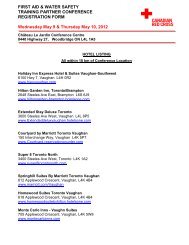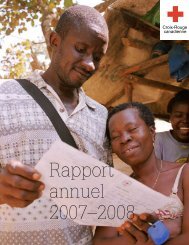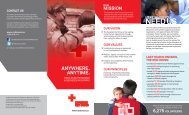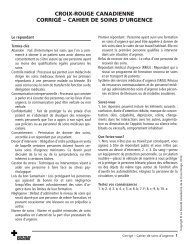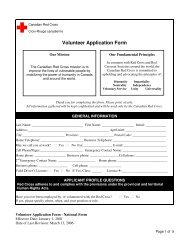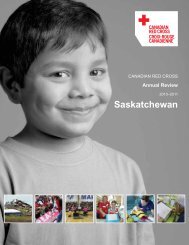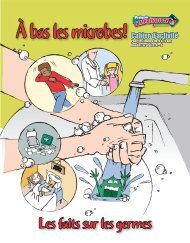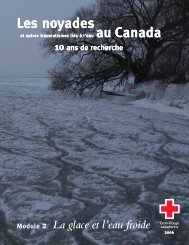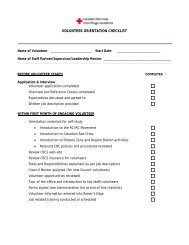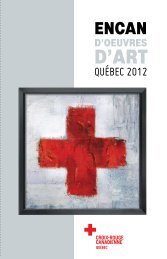NOU KA PREVWA, NOU KA EVITE - Croix-Rouge canadienne
NOU KA PREVWA, NOU KA EVITE - Croix-Rouge canadienne
NOU KA PREVWA, NOU KA EVITE - Croix-Rouge canadienne
- No tags were found...
You also want an ePaper? Increase the reach of your titles
YUMPU automatically turns print PDFs into web optimized ePapers that Google loves.
<strong>NOU</strong> <strong>KA</strong> <strong>PREVWA</strong>,34 <strong>NOU</strong> <strong>KA</strong> <strong>EVITE</strong><strong>NOU</strong> <strong>KA</strong> <strong>EVITE</strong>35<strong>NOU</strong> <strong>KA</strong> <strong>PREVWA</strong>,i. Butchart, A., Brown, D., Wilson, A., & Mikton, C. (2008). Preventing violence and reducingits impact: How development agencies can help. Organisation mondiale de la Santé.Extrait de : http://whqlibdoc.who.int/publications/2008/9789241596589_eng.pdf.ii. Butchart, A., Brown, D., Wilson, A., & Mikton, C. (2008). Preventing violence and reducingits impact: How development agencies can help. Organisation mondiale de la Santé.Extrait de : http://whqlibdoc.who.int/publications/2008/9789241596589_eng.pdf.iii. Organisation mondiale de la Santé. (2010). 10 faits sur la prévention de la violence.Extrait de : http://www.who.int/features/factfiles/violence/fr/index.html.iv. Pinheiro, P.S. (2006). World report on violence against children. New York : Nations Unies.Butchart, A., Brown, D., Wilson, A., & Mikton, C. (2008). Preventing violence and reducingits impact: How development agencies can help. Organisation mondiale de la Santé.Extrait de : http://whqlibdoc.who.int/publications/2008/9789241596589_eng.pdf;Assemblée générale des Nations Unies. (2006). Étude approfondie de toutes les formesde violence à l’égard des femmes : Rapport du Secrétaire général, 2006. A/61/122/Add.1.Extrait de : http://daccess-dss-ny.un.org/doc/UNDOC/GEN/N06/419/74/PDF/N0645974.pdf?OpenElement;Butchart, A., Brown, D., Wilson, A., & Mikton, C. (2008). Preventing violence and reducingits impact: How development agencies can help. Organisation mondiale de la Santé.Extrait de : http://whqlibdoc.who.int/publications/2008/9789241596589_eng.pdf.v. Organisation mondiale de la Santé. (2011). Disease and injury regional estimates:Cause-specific mortality: regional estimates for 2008. Extrait de : http://www.who.int/healthinfo/global_burden_disease/estimates_regional/en/index.html.vi. Klynman, Y., Kouppari, N. & Mukhier, M. (éd.) (2007). World disasters report 2007: Focuson discrimination. Fédération internationale des Sociétés de la <strong>Croix</strong>-<strong>Rouge</strong> et duCroissant-<strong>Rouge</strong> (Fédération internationale).vii. Enarson, E. (2008). Violence against women following natural disasters. Encyclopaediaof interpersonal violence. SAGE Publications. Extrait de : http://www.sage-ereference.comezp1.lib.umn.edu/view/violence/n540.xml.viii. Amnistie internationale. (2011). Doublement touchées. Des femmes s’élèvent contreles violences sexuelles dans les camps haïtiens. Extrait de : http://amnesty.org/fr/library/asset/AMR36/001/2011/fr; Centre for Human Rights and Global Justice. (2011).Sexual violence in Haiti’s IDP camps: Results of a household survey; Clermont, C.(2011). Évaluation de la situation de la violence faite aux femmes et aux filles dans leszones de Martissant et Cité Soleil; Davis, L., Gell, A., Joseph, M., Richards E.J., Patel, S.& Romero, K. (2010). Legal petition claim of precautionary measures und. Extrait de :article 25 of the Commission’s rules of procedure. International Women’s Human RightsClinic at the City University of New York School of Law, Madre, The institute for Justice& Democracy in Haiti, Bureau des Avocats Internationaux, Morrison & Foerster LLP, TheCentre for Constitutional Rights, and Women’s Link Worldwide; Human Rights Watch.(2011). Country summary. World Report 2011; Institute for Justice & Democracy in Haitiand University of Virginia School of Law. (2010). Our bodies are still trembling: Haitianwomen’s fight against rape. Extrait de : http://reliefweb.int/sites/reliefweb.int/files/resources/2AFAD9E18B0B66604925776E000646D1-Full_Report.pdf. International Gayand Lesbian Human Rights Commission / SEROVIE. (2011). L’impact du séisme et lesopérations d’aide des personnes LGBT haïtiennes. Extrait de : http://www.iglhrc.org/binary-data/ATTACHMENT/file/000/000/505-1.pdf.ix. Centre for Human Rights and Global Justice. (2011). Sexual Violence in Haiti’s IDPCamps: Results of a household survey. Extrait de : http://www.chrgj.org/press/docs/Haiti%20Sexual%20Violence%20March%202011.pdf.x. UNHCR. (2011). Driven by desperation: Transactional sex as a survival strategyin Port-au-Prince IDP camps. Extrait de : http://www.unhcrwashington.org/atf/cf/%7Bc07eda5e-ac71-4340-8570-194d98bdc139%7D/SGBV-HAITI-STUDY-MAY2011.PDF.xi. Avery, J.G. (2003). The aftermath of a disaster: Recovery following the volcanic eruptionsin Montserrat, West Indies. West Indian Medical Journal, 52: 131-5.xii. Alba, W. & Luciano, D. (2008). Salud sexual y reproductive y violencia en personasvulnerables: La tormenta Noel en Republica Dominicana. Santo Domingo, Républiquedominicaine : INSTRAW et FNUAP.xiii. Organisation mondiale de la Santé (2005). Fact sheet: Violence & disasters. Départementde la prévention des blessures et de la violence de l’Organisation mondiale de la Santé.Extrait de : http://www.who.int/violence_injury_prevention/publications/violence/violence_disasters.pdf.xiv. CIET International. (1999). Social audit for emergency and reconstruction, phase 1 –April. Coordinadora Civil para la Emergencia y la Reconstruccion (CCER); Managua,Nicaragua.xv. Larrance, R., Anastario, M. & Lawry, L. (2007). Health status among internally displacedpersons in Louisiana and Mississippi travel trailer parks. Annals of Emergency Medicine,49, 590-601.xvi. Harville, E.W., Taylor, C.A., Tesfai, H., Xiong, X. & Buekens P. (2011). Experience ofHurricane Katrina and reported intimate partner violence. Journal of InterpersonalViolence, 26(4), 833-845.xvii. Keenan, H.T., Marshall, S.W., Nocera, M.A. & Runyan, D.K. (2004). Increased incidence ofinflicted traumatic brain injury in children after a natural disaster. American Journal ofPreventive Medicine, 26 (3), P. 189-93.xviii. Enarson, E. (1999). Emergency preparedness in British Columbia: Mitigating violenceagainst women in disasters. An issues and action report for provincial emergencymanagement authorities and women’s services. 13. Extrait de : http://www.onlinewomeninpolitics.org/sourcebook_files/Resources/Report-%20Emergency%20Preparedness%20in%20British%20Columbia%20(Mitigating%20Violence%20Against%20Women%20in%20Disasters).pdfxix. Pinheiro, P.S. (2006). World report on violence against children. New York : Nations Unies.xx. Enarson, E. (1999). Emergency preparedness in British Columbia: Mitigatingviolence against women in disasters. An issues and action report for provincialemergency management authorities and women’s services. Extrait de : http://www.onlinewomeninpolitics.org/sourcebook_files/Resources/Report-%20Emergency%20Preparedness%20in%20British%20Columbia%20(Mitigating%20Violence%20Against%20Women%20in%20Disasters).pdfxxi. Adaptation du modèle écologique utilisé dans Krug, E., Dahlbert, L., Mercy, J., Zwi,A. & Lozano, R. (Eds.) (2002). Rapport mondial sur la violence et la santé. Genève :Organisation mondiale de la Santé.xxii. Birkeland, Nina M., Halff, Kate & Jennings, Edmund (éd.) (2010). Internal Displacement:Global Overview of Trends and Developments in 2009. (p. 14). Suisse : InternalDisplacement Monitoring Centre.xxiii. Enarson, E. (1999). Emergency preparedness in British Columbia: Mitigating violenceagainst women in disasters. An issues and action report for provincial emergencymanagement authorities and women’s services. 13. Extrait de : http://www.onlinewomeninpolitics.org/sourcebook_files/Resources/Report-%20Emergency%20Preparedness%20in%20British%20Columbia%20(Mitigating%20Violence%20Against%20Women%20in%20Disasters).pdf.xxiv. Ferris, E. (2010). Natural disasters, conflict and human rights: Tracing the connections.The Brookings Institution. Extrait de : http://www.brookings.edu/speeches/2010/0303_natural_disasters_ferris.aspx.xxv. Ferris, E. (2010). Natural disasters, conflict and human rights: Tracing the connections.The Brookings Institution. Extrait de : http://www.brookings.edu/speeches/2010/0303_natural_disasters_ferris.aspx.xxvi. Enarson, Elaine. Violence Against Women Following Natural Disasters, Encyclopediaof Interpersonal Violence, 2008, SAGE Publications. Extrait de : http://www.sage_ereferencecomez.p1.lib-umm.edu/view/violence/n540.xml.xxvii. Holt, K. & Hughes, S. (2007). UN staff accused of raping children in Sudan. TelegraphMedia Group. Extrait de : http://www.telegraph.co.uk.; BBC News. (2007); UN probes‘abuse’ in Ivory Coast. BBC News – Royaume-Uni. Extrait de : http://news.bbc.co.uk/go/pr/fr/-/2/hi/africa/6909664.stm; Haut Commissariat des Nations Unies pour lesréfugiés (UNHCR) et Save the Children United Kingdom. (2002). Note for implementingand operational partners by UNHCR and Save the Children-UK on sexual violence andexploitation: The experience of refugee children in Guinea, Liberia and Sierra Leonebased on initial findings and recommendations from assessment mission 22 October –30 November 2001. Extrait de : http://www.unhcr.ch/cgibin/texis/vtx/partners/opendoc.pdf?tbl=PARTNERS&id=3c7cf89a4; Save the Children United Kingdom. (2006). Fromcamp to community: Liberia study on exploitation of children. Extrait de : http://www.savethechildren.it/2003/download/pubblicazioni/Liberia/Liberia_sexual_exploitation_edited_LB.pdf; République démocratique du Congo (RDC) : La MONUC épinglée pour lemauvais comportement de certains de ses éléments.(28 août 2006). IRIN : Nouvelleset analyses humanitaires – en ligne. Extrait de : http://www.irinnews.org/report.aspx?reportid=60476xxviii. Butchart, A., Brown, D., Wilson, A., & Mikton, C. (2008). Preventing violence and reducingits impact: How development agencies can help. Organisation mondiale de la Santé.Extrait de : http://whqlibdoc.who.int/publications/2008/9789241596589_eng.pdf.xxix. Butchart, A., Brown, D., Wilson, A., & Mikton, C. (2008). Preventing violence and reducingits impact: How development agencies can help. Organisation mondiale de la Santé.Extrait de : http://whqlibdoc.who.int/publications/2008/9789241596589_eng.pdf.xxx. Ferris, E. (2010). Natural disasters, conflict and human rights: Tracing the connections.The Brookings Institution. Extrait de : http://www.brookings.edu/speeches/2010/0303_natural_disasters_ferris.aspx.xxxi. Delaney, S. (2006). La protection des enfants contre l’exploitation sexuelle et la violencesexuelle lors des catastrophes et des situations d’urgence. Bangkok, Thaïlande : ECPATInternational.xxxii. Projet Sphère. (2011). La Charte humanitaire et les standards minimums del’intervention humanitaire. Extrait de : http://www.sphereproject.org/component/option,com_docman/task,cat_view/gid,70/Itemid,203/lang,english/xxxiii. Comité permanent interorganisations (IASC). (2005). Directives en vue d’interventionshumanitaires contre la violence basée sur le sexe : Centrage sur la prévention et laréponse à la violence sexuelle dans les situations d’urgence (version à l’essai sur leterrain). Genève : IASCxxxiv. Comité permanent interorganisations (IASC). (2008). Mental health and psychosocialsupport: Checklist for field use. Genève : IASC.xxxv. Children in a Changing Climate. (2011). Children’s charter: An action plan for disaster riskreduction for children by children. Extrait de : http://plan-international.org/files/global/publications/emergencies/Childrens_Charter%20new.pdf.xxxvi. Secrétariat de la Déclaration de Genève. (2011). The Global Burden of Armed Violence2011. Geneva Declaration on Armed Violence and Development. Extrait de : http://www.genevadeclaration.org/measurability/global-burden-of-armed-violence/global-burdenof-armed-violence-2011.html.Mouvman Kwa WoujKwasans WoujEntènasyonal laopere anba sètprensip fondamantal.ImaniteKwa Wouj avantire li nan anpeche aksoulaje soufrans moun, nenpòt ki kotesa ap pase, pwoteje lavi ak lasante epiasire respè moun.San patipriSe sèlman bezwen moun ki gide KwaWouj san li pa fè diskriminasyon parapòa nasyonalite, ras, kwayans relijyon, klassosyal, oswa opinyon politik.NetralitePou li kapab genyen konfyans toutmoun, mouvman an pa ka chwazi kan, niangaje li nan konfli, kit li ta politik, ras,relijyon oswa ideyoloji.EndepandansSosyete Nasyonal yo dwe toujou kenbeotonomi yo konsa yo kapab toujou ajidapre prensip mouvman an.Sèvis VolontèSe yon mouvman volontè pou soulaje, kipa genyen okenn lide ni anvi pou reyalizepwofi.IniteKapab genyen sèlman yon Kwa Woujoswa yon Sosyete Kwasan Wouj nan yonpeyi. Li dwe la pou tout moun. Li dwe fètravay imanitè li a sou tout teritwa a.InivèsaliteMouvman Entènasyonal Kwa Wouj akKwasan Wouj la, kote tout sosyete yogenyen menm pozisyon an epi patajemenm responsabilite ak devwa yo nanede youn lòt, sou tout planèt la.



